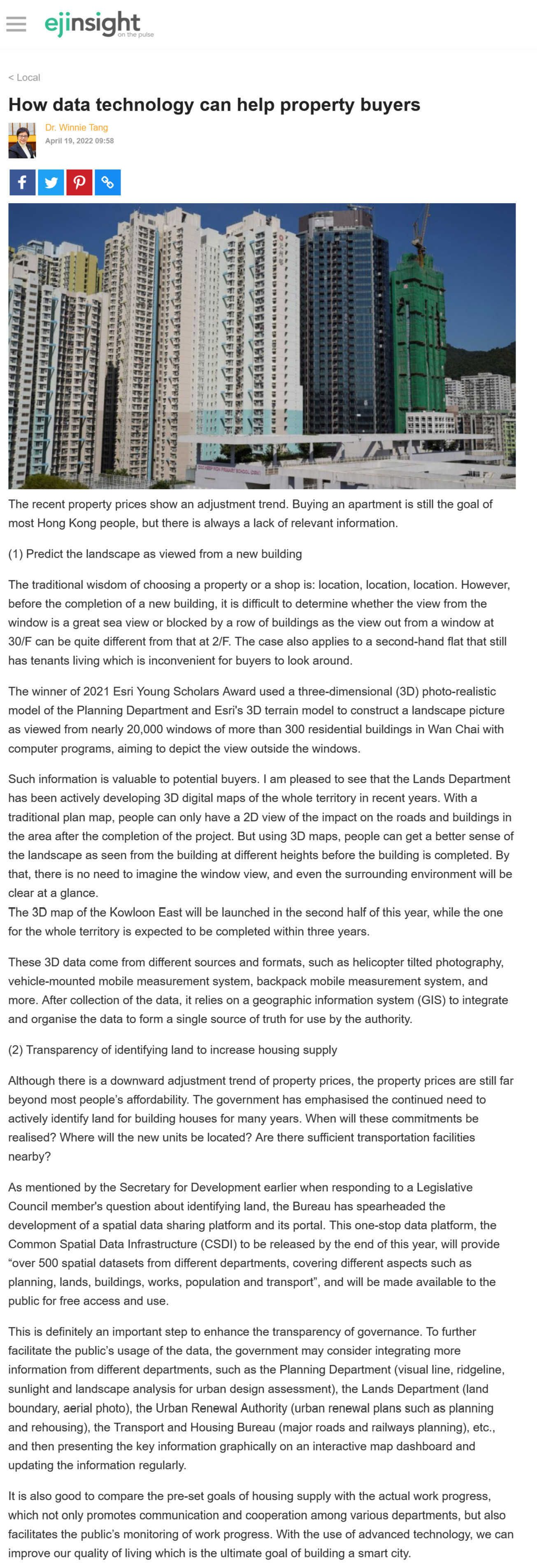網上版請按此

How data technology can help property buyers
The recent property prices show an adjustment trend. Buying an apartment is still the goal of most Hong Kong people, but there is always a lack of relevant information.
(1) Predict the landscape as viewed from a new building
The traditional wisdom of choosing a property or a shop is: location, location, location. However, before the completion of a new building, it is difficult to determine whether the view from the window is a great sea view or blocked by a row of buildings as the view out from a window at 30/F can be quite different from that at 2/F. The case also applies to a second-hand flat that still has tenants living which is inconvenient for buyers to look around.
The winner of 2021 Esri Young Scholars Award used a three-dimensional (3D) photo-realistic model of the Planning Department and Esri's 3D terrain model to construct a landscape picture as viewed from nearly 20,000 windows of more than 300 residential buildings in Wan Chai with computer programs, aiming to depict the view outside the windows.
Such information is valuable to potential buyers. I am pleased to see that the Lands Department has been actively developing 3D digital maps of the whole territory in recent years. With a traditional plan map, people can only have a 2D view of the impact on the roads and buildings in the area after the completion of the project. But using 3D maps, people can get a better sense of the landscape as seen from the building at different heights before the building is completed. By that, there is no need to imagine the window view, and even the surrounding environment will be clear at a glance.
The 3D map of the Kowloon East will be launched in the second half of this year, while the one for the whole territory is expected to be completed within three years.
These 3D data come from different sources and formats, such as helicopter tilted photography, vehicle-mounted mobile measurement system, backpack mobile measurement system, and more. After collection of the data, it relies on a geographic information system (GIS) to integrate and organise the data to form a single source of truth for use by the authority.
(2) Transparency of identifying land to increase housing supply
Although there is a downward adjustment trend of property prices, the property prices are still far beyond most people's affordability. The government has emphasised the continued need to actively identify land for building houses for many years. When will these commitments be realised? Where will the new units be located? Are there sufficient transportation facilities nearby?
As mentioned by the Secretary for Development earlier when responding to a Legislative Council member's question about identifying land, the Bureau has spearheaded the development of a spatial data sharing platform and its portal. This one-stop data platform, the Common Spatial Data Infrastructure (CSDI) to be released by the end of this year, will provide "over 500 spatial datasets from different departments, covering different aspects such as planning, lands, buildings, works, population and transport", and will be made available to the public for free access and use.
This is definitely an important step to enhance the transparency of governance. To further facilitate the public's usage of the data, the government may consider integrating more information from different departments, such as the Planning Department (visual line, ridgeline, sunlight and landscape analysis for urban design assessment), the Lands Department (land boundary, aerial photo), the Urban Renewal Authority (urban renewal plans such as planning and rehousing), the Transport and Housing Bureau (major roads and railways planning), etc., and then presenting the key information graphically on an interactive map dashboard and updating the information regularly.
It is also good to compare the pre-set goals of housing supply with the actual work progress, which not only promotes communication and cooperation among various departments, but also facilitates the public's monitoring of work progress. With the use of advanced technology, we can improve our quality of living which is the ultimate goal of building a smart city.
Dr. Winnie Tang
Adjunct Professor, Department of Computer Science, Faculty of Engineering; Department of Geography, Faculty of Social Sciences; and Faculty of Architecture, The University of Hong Kong